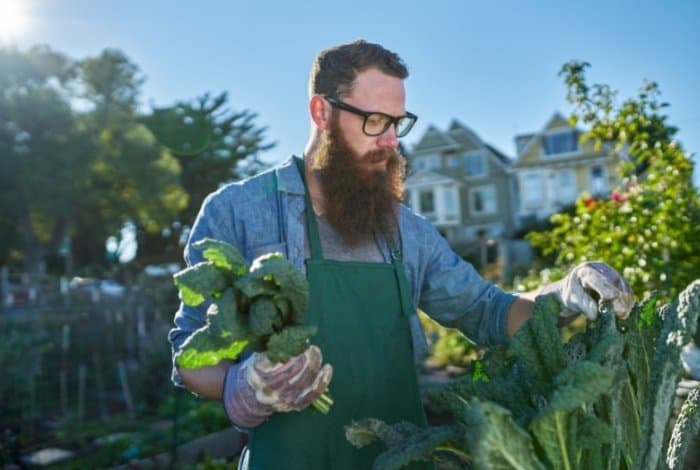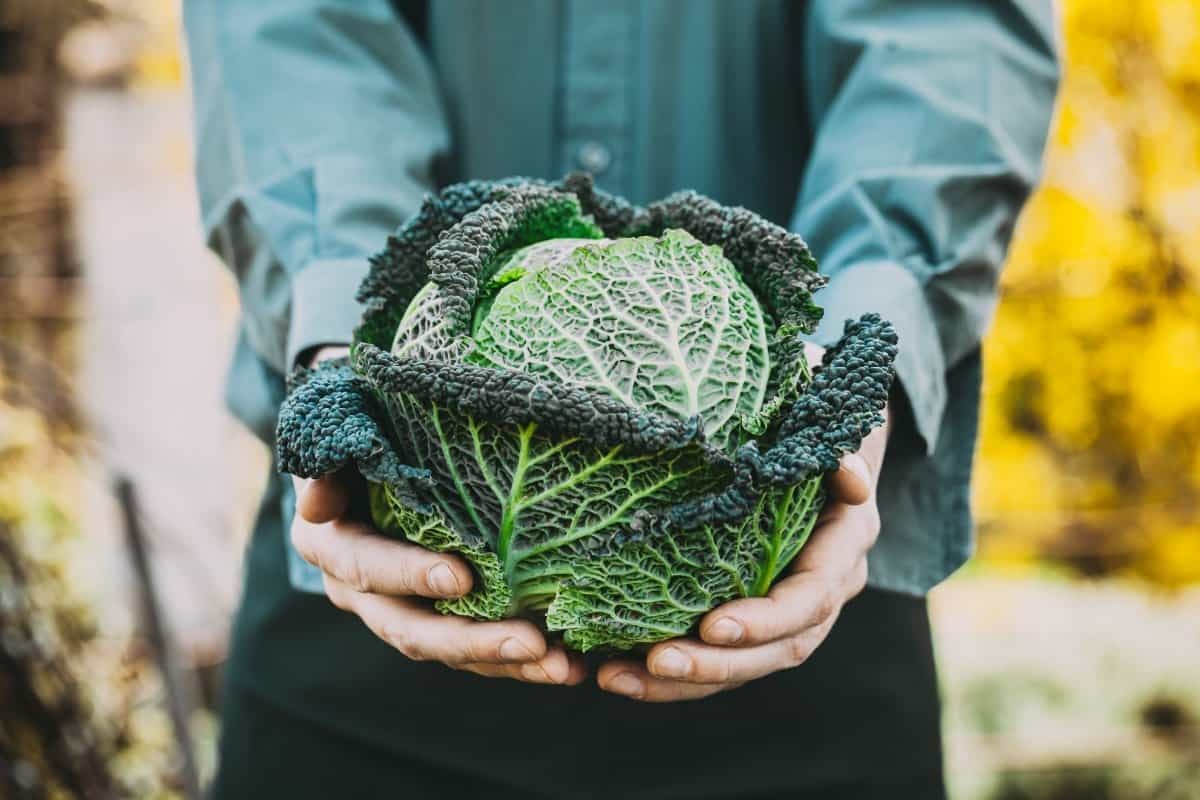Last Updated on January 20, 2022 by
When is kale ready for harvest and how do you harvest it are questions most gardeners ask that we will answer in this article.
Kale is a cabbage-type vegetable but it doesn’t form a head rather it grows leaves. It is tasty when cooked or added to salads.
Planting your kale at the right time will allow you to enjoy the leaves before the frosting season begins. Kales are quick to grow and easy to pick. They are packed with antioxidants, Vitamin A, C, and K. The right time to harvest them depends on your intended use of the leaves.
When Is Kale Ready To Harvest?
Kale is easy to grow and harvest. But you have to know the right time and method to use to harvest.
The timing and methods you use depend on the kind of kale you are growing. You could be growing plants for baby greens or mature leaves, these two take different timings.
Mature leaves are ready to pick 60 days after you have planted the seeds. At this point, the leaves are fully mature with about 10 leaves upwards. The small leaves placed in the center and larger ones on the outside.
Baby greens are ready to pick and enjoy 25 to 30 days after planting. The harvest period occurs once in late spring or early summer and again n autumn.
After the kale plants are mature, it takes just a few minutes to pick enough greens for a tasty and nutritious meal.
It is important to note that there isn’t a perfect time to pick your greens. If you like smaller leaves, go ahead and collect them earlier when they are much younger. And if you prefer them mature and larger, wait until they grow to the right size.
Note that if you wait too long, the older leaves tend to become discolored and eventually fall off the plant. If this happens, remove and discard any leaves that have changed color and continue harvesting the young leaves.
After the first harvest, you can still come back for more when the leaves are grown again about the size of an adult hand. Depending on your zone and the time of the year, you can harvest these greens every 1 to 2 weeks.
Read more about Growing Broccoli from Seed
How To Harvest-Ready Kale
It is important to note that all kales are harvested in the same way.

For Mature Plants
Take hold of the stem of a mature leaf plant right at the base and pull the main stalk. Pull it down and out until it breaks but be gentle not to break the stem. Repeat the process until you have enough kales for your use.
Leave at least five leaves on the plant so that it continues to produce new growth and photosynthesize. Do not ever pick the innermost part that has the smallest leaves as new growth originates from there.
If your plants are young and newly established or the soil is soft, use a pair of scissors or a knife to harvest your leaves instead of using your hands. This prevents you from pulling the whole plant out of the ground or breaking the main stem.
For Baby Kale
If you grow baby kales for salad, they will be ready in a few days. Harvest them by pinching them individual leaves with your fingers at the base of the stem. You may also use scissors or a knife to cut the leaves.
When choosing where to cut, consider the growth point. The central position of the kale plant is where the stems coverage and new growth emerge. To allow new growth to continue, cut the stems above the growth point to allow new growth to continue.
GROWNEER 3 Packs Pruning Shears Gardening Hand Pruning Snips
Cut the leaves where the stem connects to the larger leaves. This will leave the smaller leaves intact to continue growing.
Learn What is the Right Way to Cut Lettuce from the Garden
FAQs
When is a good time for its use?
It's one of those vegetables that are easy to grow, but can be tricky to know which varieties you should plant. I grow both 'Redbor' and 'Grand Rapids' kale in my garden, and both are fine choices for a home garden. In general, I think of kale as being more for fall and winter use.
Kale is a sturdy crop that can be planted in late fall or early spring,
How do you know when to pick kale?
You can’t see it, smell it, or taste it, so what are the telltale signs that it is time for a fresh harvest of this nutritious, tasty leafy green? It depends on where you live. The answer to that question may be different for different regions in the U.S. and even different countries. In fact, it is different around the world. But one thing is true:
I've been picking it in the garden for years, and I can tell you that when the weather gets warmer, it is just ready to be picked. As soon as the plants start getting a little more tender, they are ready. When it's time to harvest, you should take the leaves off of the stems, but don't pull the plant down.
How many times a year will it grow?
It's easy to think of kale as a perennial vegetable, but it actually grows for only a season.
Does kale grow back every year?
The leaves of kale can regrow every year, according to research by the University of California at Davis. Kale is a member of the cabbage family and its leaves are often called "cabbages" or "kales." The plant has a wide range of colors and leaf shapes, with leaves ranging from deeply lobed to broad, flat and shiny.
How tall does kale grow?
Kale grows to a height of around 10-12 inches.
Why is my kale so small?
Kale, like all other vegetables, grows best when it has access to plenty of water and nutrients. You may be surprised to know that most of the kale grown in North America comes from China. In fact, most of our produce in grocery stores is shipped from overseas. In order for a plant to grow properly, it must receive enough sunlight, water, and nutrients.
Should you prune kale?
You don’t have to worry about pruning your kale. This tender green vegetable is not in danger of becoming a big, floppy mess if it gets out of hand. I have been growing kale since I was a child. We always had a big garden and I remember that my mother would let us pick the kale leaves as we needed them.
Conclusion
FAQs
When is a good time for its use?
It's one of those vegetables that are easy to grow, but can be tricky to know which varieties you should plant. I grow both 'Redbor' and 'Grand Rapids' kale in my garden, and both are fine choices for a home garden. In general, I think of kale as being more for fall and winter use.
Kale is a sturdy crop that can be planted in late fall or early spring,
How do you know when to pick kale?
You can’t see it, smell it, or taste it, so what are the telltale signs that it is time for a fresh harvest of this nutritious, tasty leafy green? It depends on where you live. The answer to that question may be different for different regions in the U.S. and even different countries. In fact, it is different around the world. But one thing is true:
I've been picking it in the garden for years, and I can tell you that when the weather gets warmer, it is just ready to be picked. As soon as the plants start getting a little more tender, they are ready. When it's time to harvest, you should take the leaves off of the stems, but don't pull the plant down.
How many times a year will it grow?
It's easy to think of kale as a perennial vegetable, but it actually grows for only a season.
Does kale grow back every year?
The leaves of kale can regrow every year, according to research by the University of California at Davis. Kale is a member of the cabbage family and its leaves are often called "cabbages" or "kales." The plant has a wide range of colors and leaf shapes, with leaves ranging from deeply lobed to broad, flat and shiny.
How tall does kale grow?
Kale grows to a height of around 10-12 inches.
Why is my kale so small?
Kale, like all other vegetables, grows best when it has access to plenty of water and nutrients. You may be surprised to know that most of the kale grown in North America comes from China. In fact, most of our produce in grocery stores is shipped from overseas. In order for a plant to grow properly, it must receive enough sunlight, water, and nutrients.
Should you prune kale?
You don’t have to worry about pruning your kale. This tender green vegetable is not in danger of becoming a big, floppy mess if it gets out of hand. I have been growing kale since I was a child. We always had a big garden and I remember that my mother would let us pick the kale leaves as we needed them.
Many people who grow kale dislike eating it maturely because it is crunchy and dry. What they don’t know us they can make it softer by massaging it before cooking it to make it more soft and tasty.
Kale also is a great accompaniment to spinach in a salad. It makes it softer and friendly to eat. There are many recipes to use with kale that you can get online to try at home.
Kale is also loaded with health benefits like an excellent source of Vitamin C, loaded with powerful antioxidants, reduces cholesterol and reduces the risk of heart disease, has numerous cancer-fighting elements among many others. It is also a good source of minerals and affordable to everyone.
You will never look at kale like you did before!
Caroline is a gardener who loves to get down to the nitty–gritty of gardening. She proudly proclaims herself as a ‘dirt worshipper‘ and can often be found deep in the garden, covered in soil and singing to her plants. As a self–proclaimed ‘plant whisperer‘, Caroline believes that plants need love and attention just like any other living thing, and she loves to give them both. When she‘s not tending to her garden, you can often find her researching the latest gardening trends, or teaching others how to make their gardens thrive


